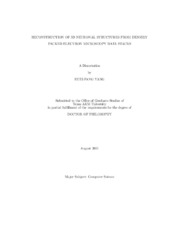| dc.contributor.advisor | Choe, Yoonsuck | |
| dc.creator | Yang, Huei-Fang | |
| dc.date.accessioned | 2012-10-19T15:29:38Z | |
| dc.date.accessioned | 2012-10-22T18:00:05Z | |
| dc.date.available | 2012-10-19T15:29:38Z | |
| dc.date.available | 2012-10-22T18:00:05Z | |
| dc.date.created | 2011-08 | |
| dc.date.issued | 2012-10-19 | |
| dc.date.submitted | August 2011 | |
| dc.identifier.uri | https://hdl.handle.net/1969.1/ETD-TAMU-2011-08-10189 | |
| dc.description.abstract | The goal of fully decoding how the brain works requires a detailed wiring diagram of the brain network that reveals the complete connectivity matrix. Recent advances in high-throughput 3D electron microscopy (EM) image acquisition techniques have made it possible to obtain high-resolution 3D imaging data that allows researchers to follow axons and dendrites and to identify pre-synaptic and post-synaptic sites, enabling the reconstruction of detailed neural circuits of the nervous system at the level of synapses. However, these massive data sets pose unique challenges to structural reconstruction because the inevitable staining noise, incomplete boundaries, and inhomogeneous staining intensities increase difficulty of 3D reconstruction and visualization.
In this dissertation, a new set of algorithms are provided for reconstruction of neuronal morphology from stacks of serial EM images. These algorithms include (1) segmentation algorithms for obtaining the full geometry of neural circuits, (2) interactive segmentation tools for manual correction of erroneous segmentations, and (3) a validation method for obtaining a topologically correct segmentation when a set of segmentation alternatives are available. Experimental results obtained by using EM images containing densely packed cells demonstrate that (1) the proposed segmentation methods can successfully reconstruct full anatomical structures from EM images, (2) the editing tools provide a way for the user to easily and quickly refine incorrect segmentations, (3) and the validation method is effective in combining multiple segmentation results. The algorithms presented in this dissertation are expected to contribute to the reconstruction of the connectome and to open new directions in the development of reconstruction methods. | en |
| dc.format.mimetype | application/pdf | |
| dc.language.iso | en_US | |
| dc.subject | Image segmentation | en |
| dc.subject | Interactive editing | en |
| dc.subject | Validation | en |
| dc.subject | Electron Microscopy | en |
| dc.title | Reconstruction of 3D Neuronal Structures from Densely Packed Electron Microscopy Data Stacks | en |
| dc.type | Thesis | en |
| thesis.degree.department | Computer Science and Engineering | en |
| thesis.degree.discipline | Computer Science | en |
| thesis.degree.grantor | Texas A&M University | en |
| thesis.degree.name | Doctor of Philosophy | en |
| thesis.degree.level | Doctoral | en |
| dc.contributor.committeeMember | Keyser, John | |
| dc.contributor.committeeMember | Shipman, Frank | |
| dc.contributor.committeeMember | Abbott, Louise C. | |
| dc.type.genre | thesis | en |
| dc.type.material | text | en |


